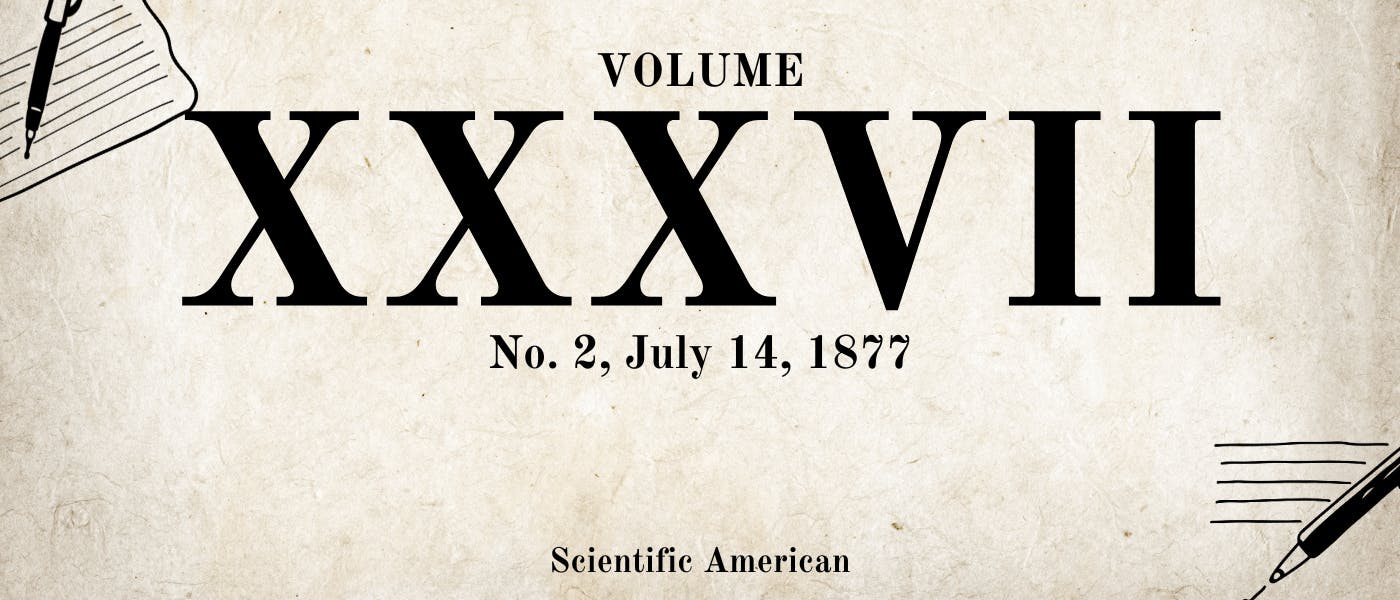Scientific American, Vol. XXXVII.—No. 2. [New Series.], July 14, 1877 by Various, is part of the HackerNoon Books Series. You can jump to any chapter in this book here. ADDRESS OF CLARENCE KING ON CATASTROPHISM.
ADDRESS OF CLARENCE KING ON CATASTROPHISM.
Mr. Clarence King lately delivered an interesting address before the Sheffield Scientific School of Yale College, New Haven, Conn., under the title of "Catastrophism, or the Evolution of Environment," which promises to evoke considerable discussion. We subjoin an abstract of the principal features of the address, which is quite lengthy. The full text will be found in our Supplements, Nos. 80, 81.
Mr. King refuted the doctrine of slow evolution as taught by Huxley and Darwin, and declared that the surface of the earth and climate had been subject to sudden and catastrophic mutation, which included in its environment all types of life.
He reasoned that marine fossils are found entombed in rocky beds far remote from present seas; and that these beds were once sea bottoms that have been upheaved by convulsions of Nature. The earliest history of mankind is pregnant with catastrophe, and we have historic story and biblical record of its sudden and destructive energy. He called to mind the vast and massive eruptions of the Pliocene basalt as seen upon our own continent.
The great obvious changes in the rocky crust were referred to a few processes; the sub-aerial decay of continents, delivery by streams of land-detritus into the sea, the spreading out of these comminuted materials upon a pelagic floor, and lastly upheaval, by which oceanic beds were lifted up into subsequent land masses. All these processes he declared to have been more rapid in the past than now. Suddenness, world-wide destructiveness, were the characteristics of geological changes. Periods of calm, like the present, are suddenly terminated by brief catastrophic epochs. Successive faunas and floras were created only to be extinguished by general cataclysms.
He believed in recurrent, abrupt accelerations of crust change, so violent as to destroy all life on the globe. He declared the idea to be the survival of a prehistoric terror, and was backed up by breaks in the great palæontological record. Of the geologic features of our continent, he said that beneath our America lies buried another distinct continent, which he called Archæan America, which was made up of what was originally ocean beds lifted into the air and locally crumpled into vast mountain chains, which were in turn eroded by torrents into mountain peaks. The original coast lines of this continent we may never be able fully to survey, but its great features, the lofty chains of the mountains which made its bones, were very nearly co-extensive with our existing systems, the Appalachians and Cordilleras. The cañon-cutting rivers of the present Western mountains have dug out the peaks and flanks of those underlying, primeval uplifts and developed an astonishing topography; peaks rising in a single sweep 30,000 feet from their bases, precipices lifting bold, solid fronts 10,000 feet into the air, and profound mountain valleys. The work of erosion, which has been carried on by torrents of the quaternary age, brings to light buried primeval chains loftier than any of the present heights of the globe.
At the close of the Palæzoic age, two enormous masses of what, probably, were then continents began to sink, and as they disappeared the present Atlantic and Pacific oceans appeared, while the sea-floor of a then ocean, emerged, and became the new continent of America. Dividing this new continent was a sea, but catastrophe removed this sea and resulted in the folding up of mountain ranges 20,000 and 40,000 feet in height, thereby essentially changing the whole climate of the continent. Of the land life of the mesozoic age we have abundant remains. The wonderful reptilian and avian fauna of the mesozoic age is now familiar to all. But after the catastrophe, and the change of climate which must necessarily have ensued, this fauna totally perished.
After criticising the opinions of Huxley, Lyell, Hutton, Darwin, and others, he recurred to the effects of sudden terrestrial or cosmical changes, and conceived that the effects of these changes would be, first, extermination; secondly, destruction of the biological equilibrium; and thirdly, rapid morphological change on the part of plastic species. When catastrophic change burst in upon the ages of uniformity, and sounded in the ear of every living thing the words "Change or die!" plasticity became the sole principle of salvation. And plasticity is the key to survival and prosperity. Mr. King remarked in conclusion of his address: "He who brought to bear that mysterious energy we call life upon primeval matter bestowed at the same time a power of development by change, arranging that the interaction of energy and matter, which make up environment should, from time to time, burst in upon the current of life and sweep it onward and upward to ever higher and better manifestations. Moments of great catastrophe, thus translated into the language of life, become moments of creation, when out of plastic organisms something newer and nobler is called into being."
About HackerNoon Book Series: We bring you the most important technical, scientific, and insightful public domain books.
This book is part of the public domain. Various (2012). Scientific American, Vol. XXXVII. —No. 2. [New Series.], July 14, 1877. Urbana, Illinois: Project Gutenberg. Retrieved https://www.gutenberg.org/cache/epub/38481/pg38481-images.html
This eBook is for the use of anyone anywhere at no cost and with almost no restrictions whatsoever. You may copy it, give it away or re-use it under the terms of the Project Gutenberg License included with this eBook or online at www.gutenberg.org, located at https://www.gutenberg.org/policy/license.html.

